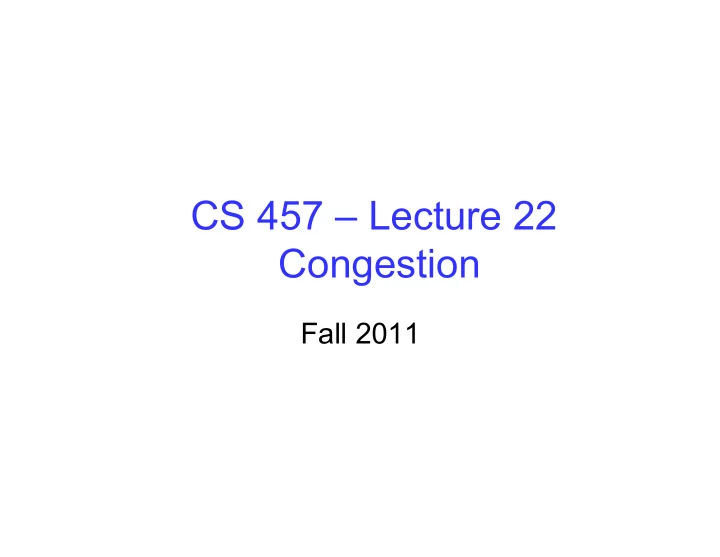

CS 457 – Lecture 22 Congestion Fall 2011
Extended Project 3 Discussion
Topics • Principles of congestion control – How to detect congestion? – How to adapt and alleviate congestion? • TCP congestion control – Additive-increase, multiplicative-decrease – Slow start and slow-start restart • Related TCP mechanisms – Nagle’s algorithm and delayed acknowledgments • TCP Throughput and Fairness • Active Queue Management (AQM) – Random Early Detection (RED) – Explicit Congestion Notification (ECN)
Resource Allocation vs. Congestion Control • Resource allocation (connection-oriented networks) – How routers meet competing demands for resources – Reservations: allocate link bandwidth and buffer space to a flow – Admission control: when to say no, and to whom • Congestion control (Internet) – How nodes prevent or respond to overload conditions – E.g., persuade hosts to stop sending, or slow down – Typically, much less exact – Have some notion of fairness (i.e., sharing the pain)
Flow Control vs. Congestion Control • Flow control – Keeping one fast sender from overwhelming a slow receiver • Congestion control – Keep a set of senders from overloading the network • Different concepts but similar mechanisms – TCP flow control: receiver window – TCP congestion control: congestion window – TCP actual window: min{congestion window, receiver window}
Internet Congestion is Unavoidable • Two packets arrive at the same time – The router can only transmit one – … and either buffer or drop the other • If many packets arrive in a short period of time – The router cannot keep up with the arriving traffic – … and the buffer may eventually overflow
Metrics: Throughput vs. Delay • High throughput – Throughput: measured performance of a system – E.g., number of bits/second of data that get through • Low delay – Delay: time required to deliver a packet or message – E.g., number of ms to deliver a packet • These two metrics are sometimes at odds – E.g., suppose you drive a link as hard as possible – … then, throughput will be high, but delay will be, too
Load, Delay, and Power Typical behavior of queuing A simple metric of how well the systems with random arrivals: network is performing: Average Power Packet delay Load Load “optimal load” Goal: maximize power �
Fairness • Effective utilization is not the only goal – We also want to be fair to the various flows – … but what does that mean? • Simple definition: equal shares of the bandwidth – N flows that each get 1/N of the bandwidth? – But, what if the flows traverse different paths? – Still a hard and open problem in the Internet
Simple Queuing Mechanism • Simplest approach: FIFO queue and drop-tail • Link bandwidth allocation: first-in first-out queue – Packets transmitted in the order they arrive • Buffer space allocation: drop-tail queuing – If the queue is full, drop the incoming packet
Limitations of FIFO/Drop Tail • Packets served on first come, first served basis • Aggressive sender can still capture most bandwidth • Seek a solution that is “fair” to all flows
Defining Fairness: Flows • First ask “fair” to whom? – Should be Fair to a Flow • What is a flow? – Source address? – Desitnation address? – Process pair? • Possible definition: <Src IP, Src Port, Dst IP, Dst Port> tuple
Defining Fairness: MaxMin • Given a resource utotal and several requests pi • Assign allocations of ui to node i. • Allocation is fair if – No one receives more than they requested: ui <= pi for all i – No other allocation has higher minimum allocation (for allocations meeting requirement above) – Recursive true after removal of minimum node: let j = user with minimum allocation let utotal = utotal - uj remove user j above conditions should still hold
What’s Next • Read Chapter 1, 2, 3, 4.1-4.3, and 5.1-5.2 • Next Lecture Topics from Chapter 6.4 and 6.5 – Congestion Control • Homework – Due Friday in recitation • Project 3 – Posted on the course webiste
Recommend
More recommend